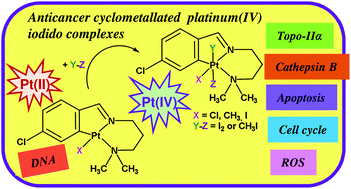Synthesis, characterization and biological activity of new cyclometallated platinum(iv) iodido complexes†
Abstract
The synthesis of six novel cyclometallated platinum(IV) iodido complexes is accomplished by intermolecular oxidative addition of methyl iodide (compounds 2a–2c) or iodine (compounds 3a–3c) upon cyclometallated platinum(II) compounds [PtX{(CH3)2N(CH2)3NCH(4-ClC6H3)}] (1a–1c: X = Cl, CH3 or I). The X-ray molecular structures of platinum(II) compound 1c and platinum(IV) compounds 3b and 3a′ (an isomer of 3a) are reported. The cytotoxic activity against a panel of human adenocarcinoma cell lines (A-549 lung, MDA-MB-231 and MCF-7 breast, and HCT-116 colon), DNA interaction, topoisomerase I, IIα, and cathepsin B inhibition, and cell cycle arrest, apoptosis and ROS generation of the investigated complexes are presented. Remarkable antiproliferative activity was observed for most of the synthesized cycloplatinated compounds (series 1–3) in all the selected carcinoma cell lines. The best inhibition was provided for the octahedral platinum(IV) compounds 2a–2c exhibiting a methyl and an iodido axial ligand. Preliminary biological results point to a different mechanism of action for the investigated compounds. Cyclometallated platinum(II) compounds 1a–1c modify the DNA migration as cisplatin. In contrast, cyclometallated platinum(IV) compounds 2a–2c and 3a–3c did not modify the DNA tertiary structure neither in the absence nor in the presence of ascorbic acid, which made them incapable of reducing platinum(IV) compounds 2b and 2c in a buffered aqueous medium (pH 7.40) according to 1H NMR experiments. Remarkable topoisomerase IIα inhibitory activity is reported for platinum(IV) complexes 2b and 3a and in addition, for the last one, a moderate cathepsin B inhibition is reported. Cell cycle arrest (decrease in G0/G1 and G2 phases and arrest in the S phase), induction of apoptosis and ROS generation are related to the antiproliferative activity of some representative octahedral cyclometallated platinum(IV) compounds (2b and 2c).



 Please wait while we load your content...
Please wait while we load your content...